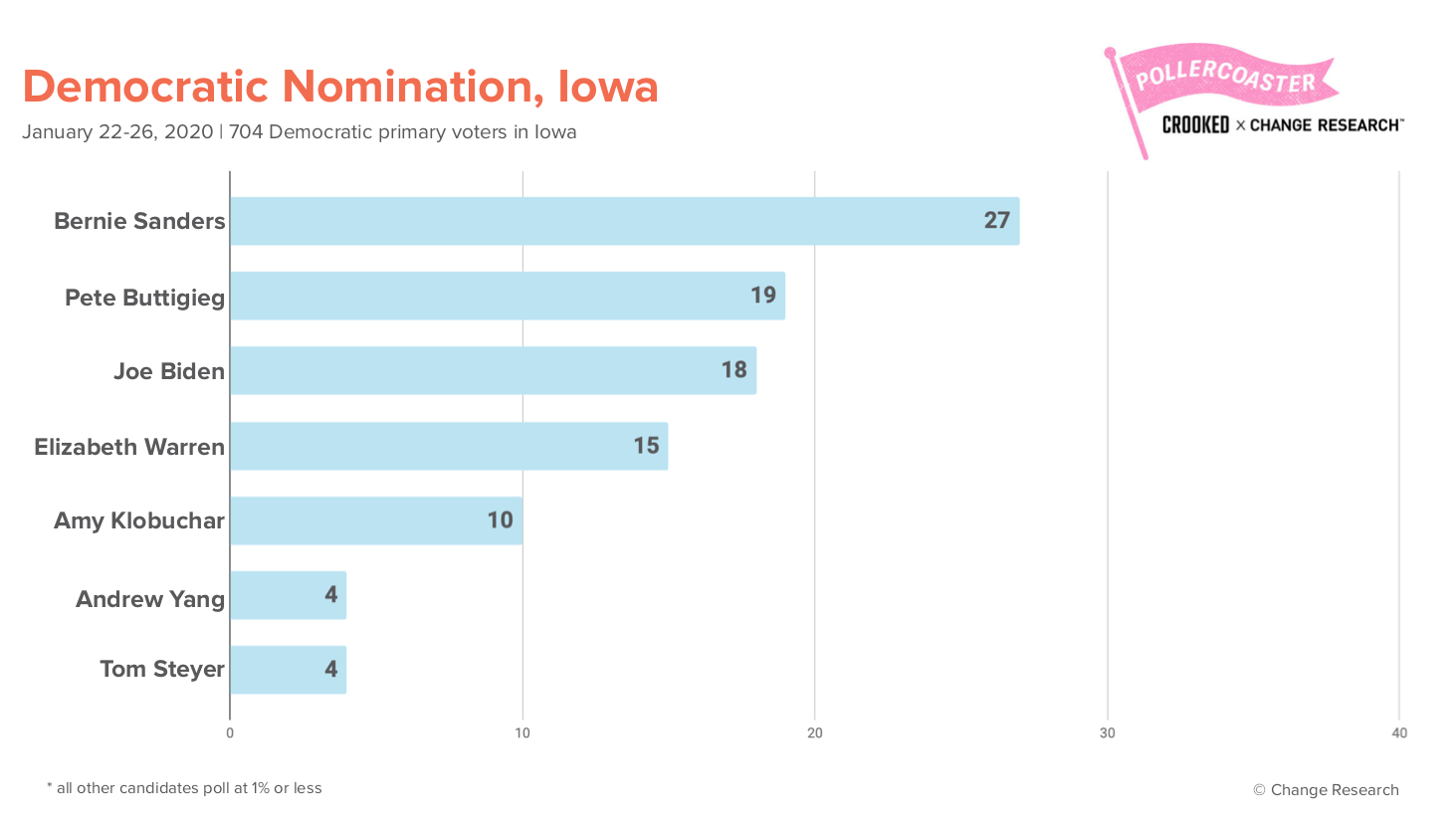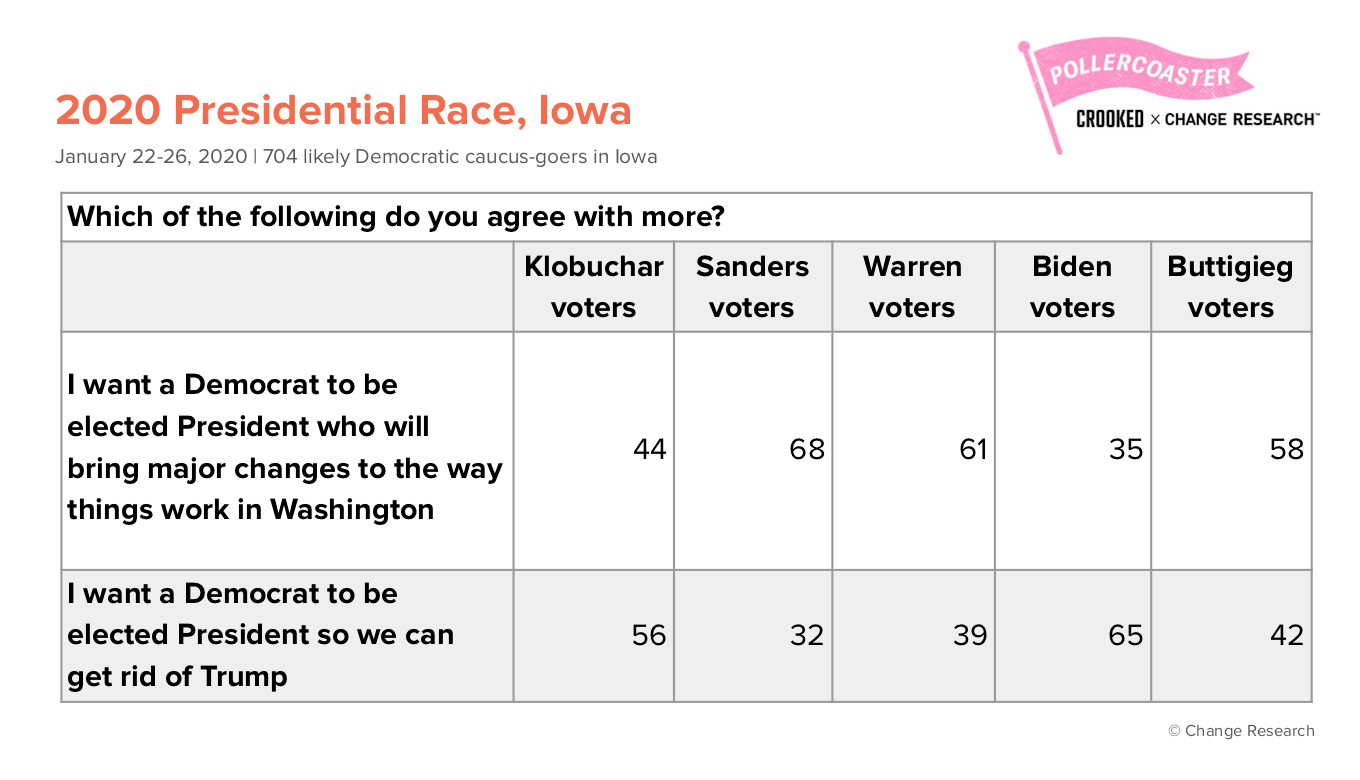Crooked Media/Change Research Iowa Poll: January 22-26, 2020
Key Takeaways:
- Bernie Sanders has an 8 point lead (27%) in the Iowa caucuses, followed by Pete Buttigieg (19%), Joe Biden (18%), Elizabeth Warren (15%), and Amy Klobuchar (10%).
- Sanders leads among all voters younger than 65; Biden leads Buttigieg by 3 points among voters 65 and older.
- 48% of caucus goers say they could still change their mind. Furthermore, 52% either have made up their mind in the last month or haven’t made up their mind at all.
- No candidate appears poised to gain disproportionately from attracting non viable candidates’ supporters.
Listen to Tommy Vietor and Jon Favreau discuss the poll results on Crooked Media’s Iowa Episode 5: Voting is Not Enough
Sanders Leads the Iowa Primary, Followed by Buttigieg, Biden, and Warren
Sanders has the support of 27% of likely caucusgoers; Buttigieg and Biden trail him with 19% and 18%, respectively; Warren is next with 15%; and Klobuchar is at 10%. Other than Yang and Steyer, at 4% each, no other candidate is above 1%.
However, many voters are still unsure. 48% of caucusgoers say they could still change their mind. Furthermore, 52% either have made up their mind in the last month or haven’t made up their mind at all. Sanders’s support is firmest: 65% of Sanders voters say they’re absolutely certain to stick with him. Warren is next on this measure, at 58%, while Buttigieg is at 53%. Only 49% of Biden’s supporters say they’re certain to caucus for him, and Klobuchar’s number is only 35%.
Of the voters who’ve made up their minds in the last week, 25% have gone with Klobuchar, suggesting she may have some momentum. Next up among that cohort of voters are Warren at 17% and Buttigieg at 16%. Among those who say they’re still making up their mind, Biden (22%) and Klobuchar (21%) lead.

No candidate is poised to gain disproportionately from attracting nonviable candidates’ supporters. Warren is the most voters’ 2nd choice, but only because she’s the most Sanders voters’ 2nd choice — and Sanders will likely be viable in most precincts. Buttigieg, Biden, and Warren are all poised to pick off a significant number of Klobuchar supporters in places where Klobuchar isn’t viable; the other candidates’ supporters fan out to the top five candidates. We see this when we ask which of the top 4 candidates voters would support if they had to choose: the margins are almost identical to how they look in the initial toplines, with Sanders at 30, Buttigieg at 23, Biden at 22, and Warren at 20. 5% say they’re not sure.
Sanders Leads Among All Voter Groups Besides 65+
Sanders has the support of 46% of caucusgoers between 18 and 34 (Buttigieg is next with 17%) and 38% of those 35-49 (Warren is next with 19%). Sanders’ lead narrows among those between 50 and 64. Voters 65 and older are closely divided: Biden has 24% of their support, while Buttigieg gets 21%, Klobuchar 20%, Sanders 15%, and Warren 13%. We estimated, based on voting history and voters’ self-stated likelihood of caucusing, that 18% of caucusgoers will be under 35, and 38% under 50. If these groups turn out at higher numbers — which is within the realm of possibility — Sanders could win by a wide margin.

What Voters are Looking for in the Democratic Nominee
29% picked their candidate because they thought they’d have the best chance to beat Trump, while 71% based their choice on who they thought would be the best President. But the differences among candidates is striking: 49% of Biden supporters chose him because they thought he’d win in November, along with 42% of Klobuchar supporters. Among Buttigieg, Sanders and Warren voters, the numbers were 22%, 20%, and 13%. We see a similar pattern when we ask voters to choose between “major change” and “getting rid of Trump.”

Change Research surveyed 704 likely Democratic caucus-goers in Iowa. The margin of error as traditionally calculated is ± 3.7% for the full sample. Change Research reaches voters via targeted online ads that point people to an online survey instrument. Our Dynamic Online Sampling delivers large samples that accurately reflect the demographics of a population. Post-stratification was done on age, gender, race, 2016 vote, and education
